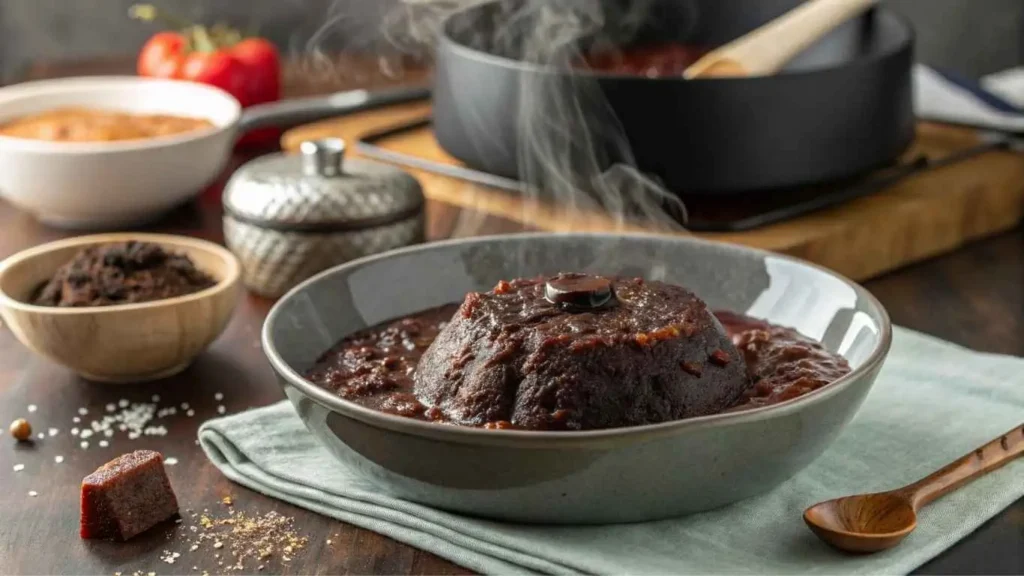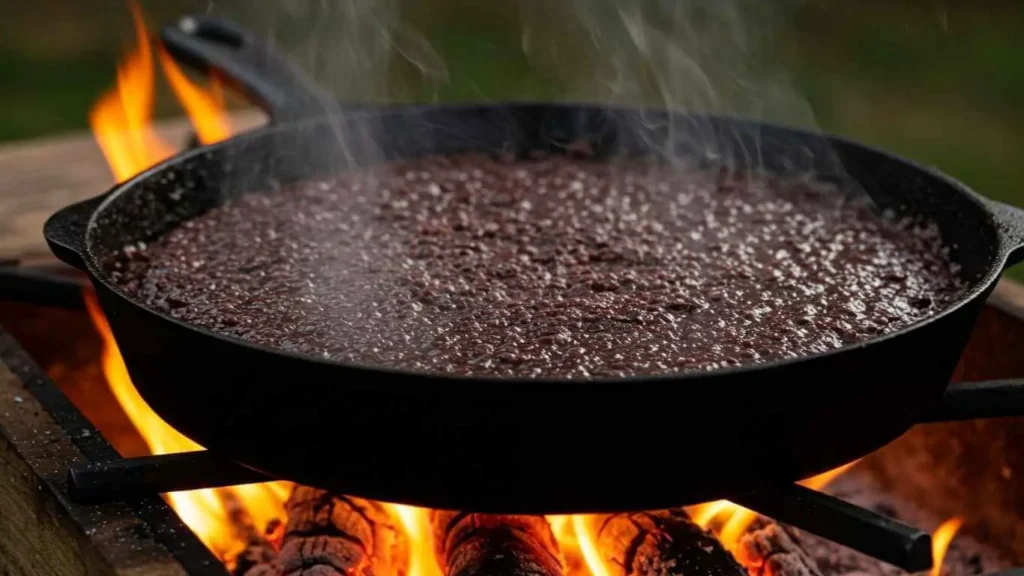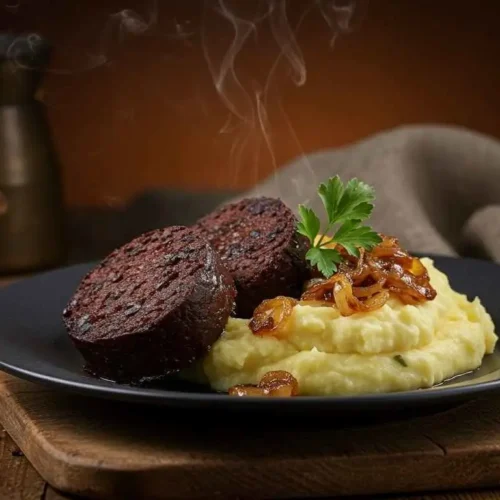Blood pudding stands as one of Europe’s most cherished comfort foods, transforming simple ingredients into a rich, satisfying meal. This traditional sausage combines fresh pig’s blood with oats, barley, or breadcrumbs to create a hearty dish that has nourished families for centuries. Many home cooks feel intimidated by making blood pudding, but this blood pudding recipe breaks down the process into manageable steps that anyone can follow.
The beauty of blood pudding lies in its versatility and incredible flavor profile. Unlike store-bought versions that often contain preservatives and artificial ingredients, homemade blood pudding offers complete control over taste and texture. You’ll discover how regional variations across Ireland, Scotland, England, and Germany each bring unique elements to this classic dish.
Modern kitchens make blood pudding preparation surprisingly straightforward. Fresh pig’s blood, available from specialty butchers or online suppliers, combines with basic pantry staples to create an authentic meal in just 30 minutes. This blood pudding recipe focuses on traditional techniques while incorporating time-saving methods that work perfectly for busy home cooks.
Recipe Card Summary
Prep Time: 15 minutes
Cook Time: 15 minutes
Total Time: 30 minutes
Servings: 6-8 portions
Difficulty: Intermediate
Cuisine: European Traditional
Quick Overview:
- Traditional blood pudding using fresh pig’s blood
- Perfect texture balance of creamy and hearty
- Authentic flavors with modern convenience
- Suitable for breakfast, lunch, or dinner
- Freezer-friendly for meal prep
Key Features:
- No artificial additives or preservatives
- Customizable spice levels
- Works with various grain combinations
- Quick 30-minute preparation
- Family-sized portions
Essential Ingredients for Perfect Blood Pudding Recipe

Primary Ingredients
Fresh Pig’s Blood (2 cups) The foundation of any authentic blood pudding recipe requires fresh, high-quality pig’s blood. Contact local butchers or specialty meat suppliers who can provide this ingredient. Fresh blood creates the signature texture and rich flavor that defines traditional blood pudding.
Steel-Cut Oats (1 cup) Steel-cut oats provide the perfect texture base, absorbing blood while maintaining slight chewiness. These oats hold their shape better than rolled oats during cooking, creating the ideal consistency for your blood pudding recipe.
Pork Fat or Suet (4 ounces, diced small) Quality pork fat adds essential moisture and richness. Fresh suet from around the kidneys works exceptionally well, though back fat serves as an excellent alternative for this blood pudding recipe.
Yellow Onion (1 large, finely chopped) Sweet onions complement the rich blood flavors perfectly. Fine chopping ensures even distribution throughout the mixture, preventing large chunks that might affect texture.
Seasoning Components
Sea Salt (2 teaspoons) Proper seasoning enhances all flavors in blood pudding. Sea salt provides clean taste without metallic undertones that table salt sometimes introduces.
Black Pepper (1 teaspoon, freshly ground) Fresh black pepper adds warmth and slight heat. Ground pepper loses potency quickly, so fresh grinding ensures maximum flavor impact.
Fresh Thyme (2 tablespoons, chopped) Thyme brings earthy, slightly minty notes that balance the richness beautifully. Fresh herbs always outperform dried versions in blood pudding recipes.
Sage Leaves (1 tablespoon, minced) Sage adds traditional flavor profiles associated with pork products. This herb complements blood pudding’s hearty nature perfectly.
Allspice (1/2 teaspoon, ground) This warm spice adds complexity without overwhelming other flavors. Allspice provides subtle sweetness that rounds out the overall taste profile.
Optional Flavor Enhancers
Grain (1/2 glass, cooked) Pre cooked grain includes distinctive surface components and conventional authenticity. Many regional blood pudding recipes include barley for extra heartiness.
Fresh Breadcrumbs (1/2 cup) Day-old bread, processed into fine crumbs, helps bind ingredients while adding subtle wheat flavors.
Apple (1 small, peeled and diced) Some regional variations include diced apple for mild sweetness that balances the rich blood flavors.
Step-by-Step Blood Pudding Recipe Instructions

Phase 1: Preparation and Setup
Step 1: Ingredient Preparation Begin your blood pudding recipe by gathering all ingredients and equipment. Fresh pig’s blood should be at room temperature for easier mixing. Dice pork fat into small, uniform pieces no larger than 1/4 inch. Finely chop onions to ensure even cooking and distribution throughout the final product.
Step 2: Oat Preparation Rinse steel-cut oats under cold running water until water runs clear. This removes excess starch that could make your blood pudding recipe gummy. Toast oats in a dry skillet for 2-3 minutes until fragrant. This step adds nutty flavors and improves texture significantly.
Step 3: Fat Rendering Heat a large skillet over medium heat. Add diced pork fat and cook slowly until pieces become golden and crispy, about 5-6 minutes. Rendered fat should be clear and aromatic. Reserve both crispy bits and liquid fat for the blood pudding recipe.
Phase 2: Base Development
Step 4: Onion Cooking Add chopped onions to the skillet with rendered fat. Cook over medium heat until onions become translucent and slightly golden, approximately 4-5 minutes. Properly cooked onions add sweetness and prevent harsh raw onion flavors in the finished blood pudding.
Step 5: Seasoning Integration Add fresh thyme, minced sage, black pepper, and allspice to the onion mixture. Cook for 30 seconds until herbs become fragrant. This blooming process releases essential oils that distribute flavors throughout your blood pudding recipe.
Step 6: Oat Incorporation Add toasted oats to the seasoned onion mixture. Stir constantly for 2 minutes, allowing oats to absorb rendered fat and herb flavors. This step creates the flavor foundation for your blood pudding recipe.
Phase 3: Blood Integration
Step 7: Temperature Management Remove skillet from direct heat. Allow mixture to cool slightly, approximately 2-3 minutes. Hot mixtures can cause blood to coagulate prematurely, affecting texture in your blood pudding recipe.
Step 8: Blood Addition Slowly pour fresh pig’s blood into the oat mixture while stirring constantly. Use a wooden spoon or silicone spatula to ensure thorough mixing. Add blood gradually to prevent lumping and ensure smooth integration.
Step 9: Seasoning Adjustment Add sea salt and taste the mixture carefully. Blood pudding should be well-seasoned but not overpowering. Adjust salt, pepper, and herbs according to personal preference.
Phase 4: Final Cooking
Step 10: Gentle Cooking Return skillet to low heat. Cook blood pudding mixture slowly, stirring frequently to prevent sticking. The mixture will gradually thicken as blood proteins coagulate and oats absorb liquid, typically taking 8-10 minutes.
Step 11: Texture Check Properly cooked blood pudding should hold together when stirred but remain creamy rather than dry. The mixture should coat a spoon lightly and not run off immediately. Overcooking creates tough, dry texture.
Step 12: Final Adjustments Remove from heat and taste for final seasoning adjustments. Add additional herbs, salt, or pepper as needed. The blood pudding recipe should have rich, balanced flavors with no single element overpowering others.
Expert Cooking Tips and Variations

Temperature Control Mastery
Success with any blood pudding recipe depends heavily on temperature management. Fresh pig’s blood contains proteins that coagulate quickly when exposed to high heat, creating undesirable lumpy textures. Keep cooking temperatures low throughout the process, never exceeding medium heat during the final cooking phase.
Use a thermometer to monitor mixture temperature if you’re new to making blood pudding. The ideal cooking temperature ranges between 160-170°F (71-77°C). This temperature range allows proteins to set properly while maintaining smooth, creamy consistency.
Regional Variation Adaptations
Irish-Style Blood Pudding Traditional Irish versions often include additional barley and sometimes potato. Add 1/2 cup cooked barley and 1 small diced, cooked potato to create authentic Irish blood pudding. These additions create heartier texture and mild flavors that complement the rich blood base.
Scottish Black Pudding Variation Scottish recipes typically use more oatmeal and include beef suet instead of pork fat. Substitute half the steel-cut oats with medium oatmeal and use beef suet for more traditional Scottish flavors. Add a pinch of nutmeg for authentic seasoning.
German Blood Sausage Style German variations often include more spices and sometimes vinegar for tang. Add 1/4 teaspoon each of marjoram, caraway seeds, and a tablespoon of apple cider vinegar to create Germanic flavors in your blood pudding recipe.
Texture Modifications
Smooth Texture Preference For silkier blood pudding, process half the oat mixture in a food processor before adding blood. This creates smoother base while maintaining some texture from whole oats.
Extra Hearty Version Double the oat quantity and add cooked pearl barley for extremely hearty blood pudding. This variation works excellently for main course servings rather than breakfast portions.
Lighter Alternative Reduce pork fat by half and add an extra egg white for binding. This creates lighter blood pudding with less saturated fat while maintaining authentic flavors.
Make-Ahead Strategies
Blood pudding mixture can be prepared up to 24 hours in advance and stored in the refrigerator. This resting period actually improves flavors as ingredients meld together. Reheat gently in a covered skillet with a splash of water or broth to prevent sticking.
For supper prep devotees, this blood pudding formula scales up beautifully. Double or triple ingredients to create multiple meals. Portion cooked blood pudding into serving sizes and freeze for up to three months.
Nutritional Information and Health Benefits
Comprehensive Nutritional Breakdown
Per Serving (1/8 of recipe):
- Calories: 245
- Protein: 18g
- Carbohydrates: 12g
- Fat: 14g
- Fiber: 2g
- Iron: 6.2mg (34% DV)
- Vitamin B12: 8.4mcg (350% DV)
- Zinc: 2.1mg (19% DV)
- Selenium: 15.6mcg (28% DV)
Essential Nutrient Benefits
Iron Content Excellence Blood pudding provides exceptional iron content, with one serving delivering over one-third of daily iron requirements. This highly bioavailable heme iron absorbs more efficiently than plant-based iron sources, making blood pudding an excellent choice for preventing iron deficiency anemia.
B-Vitamin Powerhouse This blood pudding recipe provides extraordinary vitamin B12 levels, essential for nervous system function and red blood cell formation. Many people, especially those following plant-based diets, struggle to get adequate B12. One serving provides well over daily requirements.
Complete Protein Source Blood contains all essential amino acids in optimal ratios for human nutrition. Combined with oats and pork fat, this blood pudding recipe provides complete protein that supports muscle maintenance and growth.
Mineral Density Beyond iron, blood pudding offers significant amounts of zinc, selenium, and phosphorus. These minerals support immune function, antioxidant activity, and bone health respectively.
Dietary Considerations
Keto-Friendly Adaptation Replace oats with cauliflower rice for keto-compatible blood pudding. Process raw cauliflower florets until rice-sized, then sauté until tender before incorporating into the blood pudding recipe.
Gluten-Free Naturally Traditional blood pudding using oats is naturally gluten-free, assuming certified gluten-free oats. Always verify that pig’s blood hasn’t been treated with additives containing gluten.
Paleo Considerations Remove oats entirely and substitute with finely chopped mushrooms or additional vegetables for paleo-friendly blood pudding. The mushrooms add umami flavors while maintaining substantial texture.
Creative Serving Suggestions
Traditional Breakfast Presentations
Classic Full Irish Breakfast Serve thick slices of blood pudding alongside eggs, bacon, grilled tomatoes, and soda bread. This traditional combination balances rich blood pudding with fresh vegetables and grains for complete breakfast satisfaction.
Pan-fry blood pudding slices until golden and slightly crispy on the outside while maintaining creamy interior texture. The contrast between crispy exterior and smooth interior creates appealing textural variety.
Scottish Breakfast Integration Pair blood pudding with oatcakes, smoked salmon, and scrambled eggs for authentic Scottish breakfast. The oatcakes provide neutral base that highlights blood pudding’s rich flavors without competition.
Lunch and Dinner Applications
Hearty Soup Addition Crumble cooked blood pudding into vegetable soup during the last few minutes of cooking. This adds protein and richness to simple broths, creating more substantial meals from basic ingredients.
Stuffing Enhancement Mix crumbled blood pudding into traditional bread stuffing for poultry. The blood pudding adds moisture, flavor, and protein while complementing sage and thyme seasonings typically used in stuffing recipes.
Pasta Integration Combine crumbled blood pudding with creamy pasta sauces for unique dinner presentations. The blood pudding includes lavishness comparative to pancetta or bacon whereas giving more complex flavors.
Appetizer Presentations
Canapé Creations Spread smooth blood pudding on toasted baguette slices, topped with apple slices and fresh thyme leaves. This combination balances rich blood pudding with bright, acidic apple flavors.
Stuffed Mushrooms Mix blood pudding with breadcrumbs and herbs to stuff large mushroom caps. Bake until mushrooms are tender and filling is heated through for elegant appetizer presentations.
International Fusion Ideas
Asian-Inspired Planning Season blood pudding with ginger, garlic, and soy sauce for Asian combination applications. Serve with steamed rice and stir-fried vegetables for cross-cultural meal combinations.
Mediterranean Adaptation Add sun-dried tomatoes, olives, and fresh basil to blood pudding for Mediterranean flavors. Serve with polenta or crusty bread for complete meal presentations.
Proper Storage Instructions

Short-Term Storage Solutions
Refrigerator Storage Store cooked blood pudding in airtight containers for up to four days in the refrigerator. Allow blood pudding to cool completely before refrigerating to prevent condensation that could affect texture and promote bacterial growth.
Divide large batches into meal-sized portions for convenient storage and reheating. This prevents repeated heating and cooling of entire batches, which can degrade quality and food safety.
Daily Storage Tips Wrap individual portions in plastic wrap, then place in airtight containers for double protection against air exposure and odor absorption. Blood pudding can absorb refrigerator odors easily without proper protection.
Long-Term Freezing Methods
Freezer Preparation Cool blood pudding completely before freezing. Wrap portions tightly in plastic wrap, then aluminum foil for maximum protection against freezer burn. Properly wrapped blood pudding maintains quality for up to three months.
Label packages with contents and date to ensure proper rotation. Frozen blood pudding maintains food safety indefinitely but quality decreases after three months.
Freezing Portions Freeze blood pudding in serving-size portions rather than large containers. This allows thawing only needed amounts while keeping remaining portions frozen and fresh.
Reheating Guidelines
Safe Reheating Methods Thaw frozen blood pudding overnight in the refrigerator before reheating. Never thaw at room temperature, which promotes dangerous bacterial growth.
Reheat blood pudding gently in covered skillet over low heat, adding small amounts of water or broth if mixture seems dry. Stir frequently to ensure even heating throughout.
Microwave Reheating For quick reheating, use microwave at 50% power in 30-second intervals, stirring between intervals. High microwave power can create hot spots and tough texture in reheated blood pudding.
Oven Reheating Reheat larger portions in 350°F (175°C) oven, covered with foil to prevent drying. Heat for 15-20 minutes until heated through, stirring halfway through heating time.
Frequently Asked Questions
Where can I buy fresh pig’s blood for this blood pudding recipe?
Contact local butchers, specialty meat markets, or ethnic grocery stores that cater to European or Latin American communities. Many butchers can order fresh pig’s blood with advance notice, typically requiring 24-48 hours. Some online suppliers also ship fresh pig’s blood with proper refrigeration.
When purchasing pig’s blood, ensure it comes from inspected facilities and appears bright red without dark clots or off odors. Fresh blood should flow smoothly and smell clean, not metallic or sour.
Can I substitute other types of blood in this blood pudding recipe?
Beef blood or lamb blood work as substitutes, though they create slightly different flavors and textures. Beef blood produces earthier taste, while lamb blood adds mild gamey notes. Chicken or duck blood creates lighter colored, more delicate blood pudding.
The cooking process remains identical regardless of blood type used. Adjust seasonings according to the specific blood flavor characteristics.
Why did my blood pudding turn out lumpy or grainy?
Lumpy texture typically results from cooking blood at too high temperature, causing proteins to coagulate rapidly. Always use low heat and add blood gradually while stirring constantly. Temperature control is crucial for smooth blood pudding recipe success.
Grainy texture often indicates insufficient mixing or blood that wasn’t fresh. Ensure thorough mixing when adding blood, and always use the freshest blood possible for best results.
How do I know when blood pudding is properly cooked?
Properly cooked blood pudding holds together when stirred but remains creamy rather than dry or crumbly. The mixture should coat a spoon lightly and have uniform color throughout without streaks of uncooked blood.
Internal temperature should reach 160°F (71°C) for food safety. Use an instant-read thermometer if you’re uncertain about doneness.
Can I make blood pudding without pork fat?
Yes, substitute beef suet, duck fat, or even butter for pork fat in this blood pudding recipe. Each fat type creates different flavor profiles, with beef suet providing richest taste and butter creating milder flavors.
For lower-fat versions, reduce fat quantity by half and add an extra egg for binding. This creates lighter blood pudding while maintaining structural integrity.
Is homemade blood pudding safe to eat?
Homemade blood pudding is safe when prepared with fresh ingredients and proper cooking temperatures. Always source blood from reputable suppliers who follow food safety regulations.
Cook blood pudding to internal temperature of 160°F (71°C) and consume within recommended storage timeframes. Follow standard food safety practices throughout preparation and storage.
Can I prepare blood pudding recipe in advance?
Blood pudding mixture can be prepared up to 24 hours ahead and refrigerated before final cooking. This resting period often improves flavors as ingredients meld together.
Cooked blood pudding stores well for several days and reheats beautifully, making it excellent for meal prep and advance planning.
What’s the distinction between blood pudding and dark pudding?
Blood pudding and dark pudding allude to the same dish, with territorial naming preferences. British and Irish sources typically use “black pudding,” while other regions prefer “blood pudding.” Both terms describe the same traditional sausage made with pig’s blood and grain.
Can children eat blood pudding made from this recipe?
Blood pudding provides excellent nutrition for children, including high iron and B-vitamin content. However, some children may resist the concept or appearance. Introduce blood pudding gradually, perhaps mixed into familiar dishes initially.
Ensure blood pudding is thoroughly cooked and stored properly when serving to children, following the same food safety guidelines as any meat product.
Why is my blood pudding recipe too salty or bland?
Taste preferences vary significantly with blood pudding. Start with recommended salt amounts, then adjust according to personal preference. Remember that blood itself contains natural sodium, so additional salt requirements may be less than expected.
For flat blood pudding, increment herbs and flavors or maybe than fair salt. Fresh thyme, sage, and black pepper significantly improve flavor without excessive sodium.
Conclusion
This comprehensive blood pudding recipe transforms traditional European comfort food into an accessible, 30-minute meal that delivers exceptional nutrition and authentic flavors. By following these detailed instructions, home cooks can master the techniques that create perfectly textured, richly flavored blood pudding without intimidation or guesswork.
The key to successful blood pudding lies in understanding temperature control, ingredient quality, and timing. Fresh pig’s blood, properly rendered fat, and gentle cooking methods combine to create the signature texture and taste that makes this dish so beloved across European cultures.
Modern home cooks benefit from simplified techniques that maintain traditional authenticity while accommodating busy lifestyles. This blood pudding recipe scales easily for meal prep, freezes beautifully for future meals, and adapts to various dietary preferences without losing essential character.
Whether served as part of traditional breakfast presentations, incorporated into creative lunch applications, or featured in elegant dinner preparations, homemade blood pudding offers versatility that store-bought versions simply cannot match. The ability to control ingredients, adjust seasonings, and ensure freshness makes homemade blood pudding superior in both taste and nutrition.
Regional variations provide endless opportunities for customization, allowing cooks to explore Irish, Scottish, German, and other European traditions within a single recipe framework. These adaptations keep blood pudding preparation interesting while honoring cultural heritage.
The exceptional nutritional profile, including high iron content, complete proteins, and essential B-vitamins, makes blood pudding an excellent choice for health-conscious cooks seeking traditional foods with modern nutritional benefits. Few dishes provide such concentrated nutrition in such satisfying, comforting form.
Storage and reheating guidelines ensure that this blood pudding recipe fits seamlessly into meal planning routines, offering convenience without sacrificing quality. Proper storage techniques maintain freshness and safety while preserving the careful work invested in preparation.
With practice, this blood pudding recipe becomes an invaluable addition to any cook’s repertoire, providing authentic European flavors, exceptional nutrition, and endless versatility in just 30 minutes of active preparation time.
Blood Pudding Recipe
Ingredients
- 1 lb pork blood fresh or reconstituted
- 1 cup steel-cut oats
- 1/2 cup pork fat finely diced
- 1 medium onion finely chopped
- 1/2 tsp ground allspice
- 1 tsp salt
- 1/2 tsp black pepper
- 1/2 cup milk optional, for moistening oats
- Casing or loaf tin for shaping
Instructions
- Prepare the oats: Soak the steel-cut oats in warm water or milk for about 30 minutes until softened. Drain any excess liquid if needed.
- Cook the onions: In a skillet, sauté chopped onions in a bit of pork fat or oil until translucent. Set aside to cool.
- Mix ingredients: In a large bowl, combine the softened oats, cooked onions, diced pork fat, salt, pepper, allspice, and pork blood. Stir thoroughly until the mixture is uniform.
- Shape and stuff: Pour the mixture into a greased loaf tin or sausage casing. If using a tin, line it with parchment paper.
- Bake or simmer:
- For loaf: Preheat oven to 350°F (175°C) and bake the loaf in a water bath (place the loaf tin in a larger pan filled with hot water) for about 30 minutes or until firm.
- For casing: Tie off the ends and simmer gently in water (not boiling) for 30–40 minutes.
- Cool and slice: Allow the blood pudding to cool completely. Once set, slice and pan-fry each piece until crispy on the outside before serving.
Notes
- This recipe is traditionally served as part of a full Irish breakfast but also pairs well with mashed potatoes, apples, or mustard sauce.
- Ensure the blood is fresh and handled safely refrigerated and used the same day.
- You can freeze the uncooked or cooked pudding for later use.
- Add a pinch of cloves or thyme for an herbal twist.
- If you can’t find pork blood locally, look for dried blood powder as an alternative.




